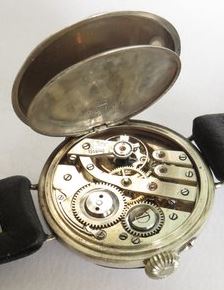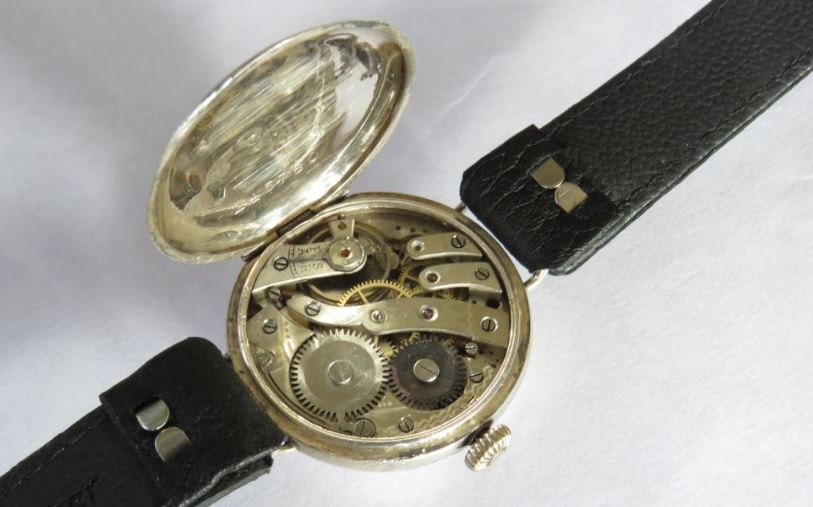The word ébauche is borrowed from the world of fine art, where it refers to the preliminary underpainting over which a finished painting is done. Ébauche movements are essentially unbranded movements that are sold on to watchmakers. The watchmakers would assemble the components and then embellish the movement by polishing or branding. They would then fit them into a pocket watch case and sell them to the unsuspecting public. This system was known in French as établissage. A watchmaker who works according to this system is known as an établisseur.
Prior to the 1850s, most watches were made by hand in a single establishment. Every component would be manufactured in-house, assembled and made into a completed watch. After the 1850s when mechanised manufacturing methods were available, movement manufacturers began making the ébauche or blank movements. The trend continues in modern times with manufacturers such as ETA or Sellita effectively making ébauche movements and selling them to a huge number of watchmakers. The modern watch that I’m wearing as I type is an Oris 65 divers watch with a Sellita SW200 base movement. This has been modified into the Oris 733 Automatic movement and placed into an Oris 65 case with a bronze bezel.
Historic producers of ébauche movements used in antique pocket watches include companies such as A. Schild, Fabrique d’Horlogerie de Fontainemelon (FHF), Gallet & Cie (company), Landeron, Venus and Lemania. Many of these ébauche manufacturers have either gone out of business or merged with watchmaking conglomerates.
A. Schild S.A. (also known as ASSA)
Adolph Schild was a noted manufacturer of ébauche movements. Schild formed his company in 1896 in Grenchen, Switzerland. By the 1920’s he was one of the largest movement manufacturers in Switzerland. He was one of the earliest manufacturers to realise that a mechanised system of production could produce standardised components that were easily interchangeable. Adolph Schild movements were greatly respected for their reliability.
Fabrique d’Horlogerie de Fontainemelon
Fabrique d’Horlogerie de Fontainemelon (FHF) was a Swiss watch movement manufacturer. It was founded in 1793 by Isaac and David Benguerel along with Julien and Francois Humbert-Droz in Fontainemelon under the name “Benguerel & Humbert”. They specialised in producing ébauche movements. The first workers were employed, working from their homes in the traditional Swiss system called établissage. However, soon after formation, a factory was constructed and the workers were brought under one roof. In 1816 FHF started mechanised production of watch movements. They were one of the earliest manufacturers to adopt powered machinery for watch production. They continued to operate successfully until the early 20th century. FHF became part of Ebauches SA in 1926 and then became part of the ETA group in 1985.

Gallet & Cie
Gallet is considered the world’s oldest watch and clock making house with history dating back to Humbertus Gallet, a clockmaker in Geneva, Switzerland in 1466. The Gallet & Cie (Gallet & Company) name was officially registered by Julien Gallet in 1826. At this time the business relocated from Geneva to La Chaux-de-Fonds, Switzerland. Prior to the official formation of the company, operations occurred under the name of each of the Gallet family patriarchs.
La Chaux-de-Fonds is known as the ‘watch valley’. It was founded in 1656 and its ongoing growth and prosperity were mainly due to the watch-making industry. Gallet was able to capitalise on the abundance of watchmaking resources and talents that resided within the city walls. It allowed the company to modernise its production methods and increase its range of brands. Each of the brands was designed to target a different demographic. Lower priced watches were supplied to the average working man, as well as expensive high-grade and complicated timepieces in solid gold cases for the wealthy. In addition to their own brands, Gallet & Cie were known for producing ébauche movements that could be offered to retail watchmakers.
Lemania
Originally known as Lugrin S.A, Lemania was founded in 1884 by Alfred Lugrin, who had honed his watchmaking skills at Jaeger-LeCoultre. Due to his outstanding watchmaking skills, he received awards and gold medals at exhibitions in Milan in 1906 and in Berne in 1914. Alfred specialised in the production of chronographs, stopwatches and repeaters. In addition, the company produced ébauche movements, which were supplied to other well-known manufacturers. In 1930 the brand name Lemania was adopted and they produced their own branded watches.
Read about other Manufacturers and Makers.
